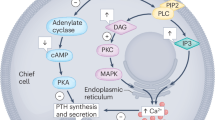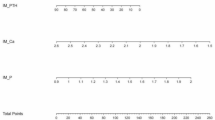Abstract
VARIOUS theories have been put forward to explain the excessive calcium output in thyrotoxicosis including an increased metabolism per se1, neutralization of acid products2, direct stimulating catabolic action of thyroxin on bone, and a co-existing hyper-parathyroidism3. For reasons to be given later, all these theories are unsatisfactory. As a result of direct experiments and observations4 on normal subjects and cases of thyrotoxicosis, myxœdema and parathyroid tetany, a new theory has been formulated. It is believed that in thyrotoxicosis, an excessive secretion of thyroxin acts directly on the kidneys, stimulating them to increase their output of calcium. This may be achieved either as a result of the increased metabolism per se or by lowering the renal threshold for calcium.
This is a preview of subscription content, access via your institution
Access options
Subscribe to this journal
Receive 51 print issues and online access
$199.00 per year
only $3.90 per issue
Buy this article
- Purchase on SpringerLink
- Instant access to full article PDF
Prices may be subject to local taxes which are calculated during checkout
Similar content being viewed by others
References
Aub, J. C., Bauer, W., Heath, C., and Ropes, M., J. Clin. Invest., 7, 97 (1929).
Hoennicke, E., Biol. klin. Woch., 41, 1154 (1904).
Hansman, F. S., and Wilson, F. H., Med. J. Austr., 1, 37 (1934).
Robertson, J. D., Lancet, 1, 97, 129, 156, 216 (1941).
Author information
Authors and Affiliations
Rights and permissions
About this article
Cite this article
ROBERTSON, J. Nature of the Disturbed Calcium Metabolism in Thyrotoxicosis and Myxœdema. Nature 148, 724 (1941). https://doi.org/10.1038/148724b0
Issue date:
DOI: https://doi.org/10.1038/148724b0



